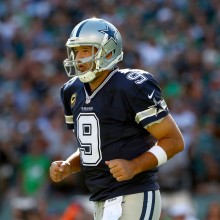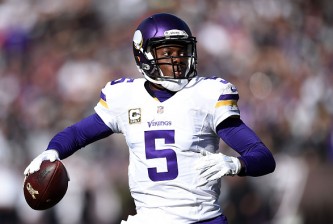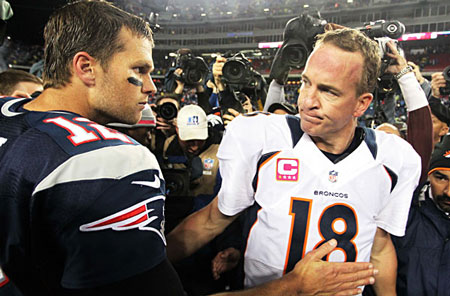He set the touchdown record.
He set the yardage record.
Peyton Manning did it all in 2013, putting up "Star Wars" numbers en route to what will certainly be his unprecedented fifth MVP award.
While Manning's exploits were remarkable, do they constitute the greatest passing season in history? Was it enough to pass Drew Brees and Tom Brady on his way to holding two of the biggest passing records in the books?
It's no surprise that Manning's stiffest competition may come from himself.
The Candidates
When looking for the greatest passing season in history, it's helpful to limit by eras. For the purposes of this study, only Super Bowl Era passers will be considered. It's just too complicated to try and compare pre-modern passers here.
Tom Brady 2007
Brady set the touchdown record in 2007 with a barrage of bombs to Randy Moss. His Patriots went undefeated in the regular season, and Brady was rewarded with his first MVP award.
Peyton Manning 2004
Manning's first "holy crap" season culminated in 49 touchdowns and a then-record 121.1 passer rating. He won his second MVP award as a result.
Dan Marino 1984
For twenty years, this was the gold standard of quarterback play. 48 touchdowns and a trip to the Super Bowl are hard to argue with.
Drew Brees 2011
Brees has had several 5,000 yard efforts, but this one came with 46 touchdowns. Oh, and he didn't win the MVP award.
Aaron Rodgers 2011
Brees didn't win the award, because Rodgers did. He broke Manning's passer rating record with a 122.5 effort, firing 45 touchdowns to just six interceptions.
The Criteria
High-volume passing numbers are exciting, but efficiency has to be considered in balance. Obviously, the less someone throws, the easier it is to sustain high marks in rate stats. The question is how much additional value came from the extra throws. For instance, 2010 Tom Brady and 2006 Peyton Manning both posted DVOA numbers worth of inclusion in this study, but their volume numbers were suppressed.
Additionally, it's important to take into account the passing environment and opposing defenses. Advanced metrics from the Football Outsiders can help with that.
To begin, here are the raw numbers for each of the candidates:
| Att | Comp | Comp % | Yards | YPA | TD | INT | Rating | DYAR | DVOA | |
| Brady 07 | 578 | 398 | 68.9 | 4806 | 8.3 | 50 | 8 | 115.1 | 2674 | 54.1% |
| Manning 04 | 497 | 336 | 67.6 | 4557 | 9.2 | 49 | 10 | 121.1 | 2434 | 59.5% |
| Marino 84 | 564 | 362 | 64.2 | 5084 | 9.0 | 48 | 17 | 108.9 | N/A | N/A |
| Rodgers 11 | 502 | 343 | 68.3 | 4643 | 9.3 | 45 | 6 | 122.5 | 2059 | 38.3% |
| Brees 11 | 657 | 468 | 71.2 | 5476 | 8.3 | 46 | 14 | 110.6 | 2259 | 46.6% |
| Manning 13 | 659 | 450 | 68.3 | 5477 | 8.3 | 55 | 10 | 115.1 | 2490 | 47.9% |
Every player on this list brings something to the table. Brady has the highest DYAR, a volume metric that factors in strength of opposition. Brees put up a record completion percentage. Manning had the best ever DVOA (a rate statistic that factors in strength of opposition) in 2004. Rodgers put up the fewest interceptions and highest passer rating. Marino's record stood unchallenged the longest.
As Manning's '04 season had the fewest attempts, it's useful to examine how much marginal value was added from the additional passes thrown by his competitors.
| Att | Comp | Comp % | Yards | YPA | TD | INT | DYAR | |
| Brady 07 | 81 | 62 | 76.5% | 249 | 3.1 | 1 | -2 | 240 |
| Marino 84 | 67 | 26 | 38.8% | 527 | 7.9 | -1 | 7 | N/A |
| Rodgers 11 | 5 | 7 | 140.0% | 86 | 17.2 | -4 | -4 | -375 |
| Brees 11 | 160 | 132 | 82.5% | 919 | 5.7 | -3 | 4 | -175 |
| Manning 13 | 162 | 114 | 70.4% | 920 | 5.7 | 6 | 0 | 56 |
This chart helps illustrate the diminished effectiveness that the additional throws had. Rodgers and '04 Manning had virtually the same number of throws with Rodgers being a touch more efficient, though perhaps against weaker opposition.
Brady's season comes up short in this metric, as his additional 81 throws only netted an extra 249 yards and a single score.
Brees and 2013 Manning both put up the equivalent of four to five extra games' worth of passing attempts over 2004 Manning. The question is how to weigh those extra throws. It's interesting that even with the additional attempts, Brees still posted a lower DYAR than '04 Manning did.
In many ways, the most comparable seasons are Manning's 2013 and Brady's 2007. Yes, Manning broke Brady's record, but he threw an extra 81 passes to do it. He was extremely efficient over those 81 passes, but he did have to throw them.
In the end, both players come up short compared to 2004 Manning. That year, Manning posted a blend between the efficiency of Rodgers and the volume of everyone else on the list. Manning sat virtually the entire 16th game that season, and it conservatively cost him at least another touchdown or two.
If the criteria is a blend between efficiency, volume and opposition, then Manning's 2004 is probably still the best season a passer has had in this era of play.
Manning's 2013 records won't stand forever (heck, they might not even stand for the rest of the week), but they are an amazing accomplishment. Whether they represent the greatest passing season of all time or not is still up for debate. For the sheer durative nature of his accomplishments, Marino's 1984 will always be a gem. He'll hold the records longer than Manning ever will.























